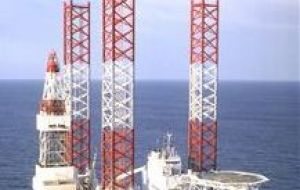MercoPress. South Atlantic News Agency
Drilling record: 7 miles extended-reach oil well off Russia
 Exxon oil rig
Exxon oil rig Exxon Mobil Corporation, the world's largest oil company recently broke its own industry record for the longest “extended-reach” oil well: more than seven miles from the frigid shores of Sakhalin Island off Russia's east coast.
Such wells begin vertically on land and then curve to bore through layers of rock under the seabed to offshore reservoirs. The Sakhalin well is 8,350 feet beneath the Sea of Okhotsk and 38,322 feet from shore to reservoir, beating Exxon's previous record of 37,016 feet. The 230-foot-tall Yastreb rig on the Chayvo project, operated by Houston-based Parker Drilling, also holds a title: the world's most powerful land drilling rig. Such wells push technological limits to steer the drill bit and withstand massive pressures and temperatures. They also negate the need for pipelines and offshore platforms, particularly in harsh arctic areas like Sakhalin where conditions don't favor such installations and onshore facilities reduce environmental impact. Jerome Schubert, an assistant professor of petroleum engineering at Texas A&M University whose research includes extended-reach drilling, said the practice isn't new. But pushing wells as far from shore as Exxon Mobil has illustrates how technological advances increase access to undersea oil. "It kind of gives them bragging rights," Schubert said. "It's, 'We've gotten a little farther,' and it gives a target for someone else. "But they're not going to try to beat the record just to beat the record. Every time they drill another extended-reach well, they get better at it". To meet ever-growing global demand, companies are pushing to reach oil and gas in remote areas once deemed too difficult to tap. The Chayvo field was discovered nearly 30 years ago, but sat untouched until new technologies made it accessible. Potentially it holds a billion barrels of oil. Similar challenges also once hindered drilling in other areas, including the deep-water Gulf of Mexico. There, Chevron holds the record for the deepest vertical well: 34,189 feet in the company's Knotty Head development about 170 miles southeast of New Orleans. Deep water Gulf drilling requires the ability to plow through a thick, undulating salt layer as well as rock and sediment amid high pressures. The salt makes it more difficult to scope out reservoirs, even using 3-D seismic imaging that Exxon Mobil pioneered. The Sakhalin drilling doesn't contend with salt, but has a host of other challenges, including the need to control friction between pipe used in drilling and rock as the well-path curves to head offshore. And when the horizontal path traverses layers of softer rock it must be protected from caving in. The Sakhalin team evaluates each step with real-time digital data, he said. Exxon Mobil began studying Sakhalin exploration in the late 1980s. In 1996, as the operator of a consortium that owns the multiphase project, the company forged an agreement with the Russian government to get started. Exxon Mobil has a 30% interest in the project. The other partners are affiliates of Russia's Rosneft RN-Astra and Sakhalinmorneftetgas-Shelf; Japan's Sakhalin Oil and Gas Development; and India's ONGC Videsh. The entire Sakhalin-1 project involves development of the Chayvo, Odoptu and Arkutun-Dagi fields, which combined have potentially recoverable reserves of 2.3 billion barrels of oil. The first Chayvo well was drilled in 2003 and production began two years later. The project reached peak production of 250,000 barrels a day a year ago.




Top Comments
Disclaimer & comment rulesCommenting for this story is now closed.
If you have a Facebook account, become a fan and comment on our Facebook Page!